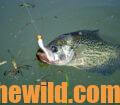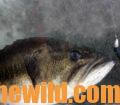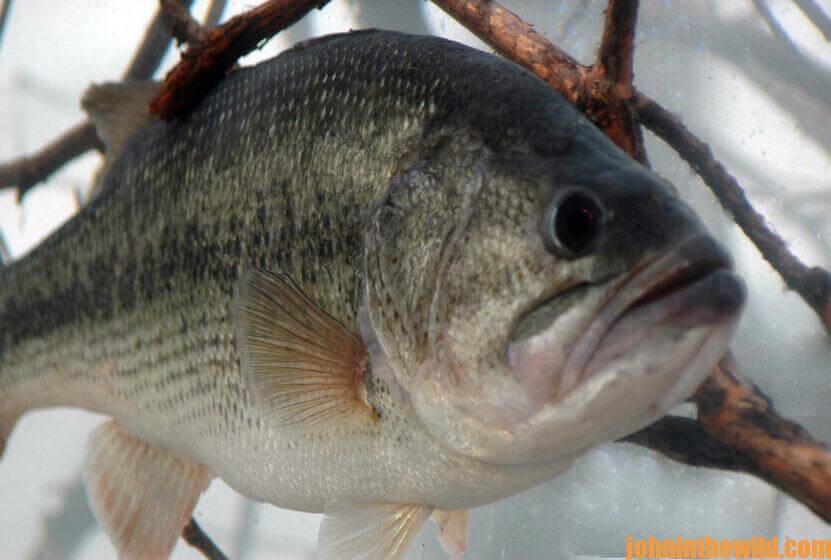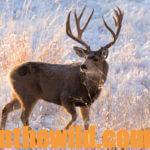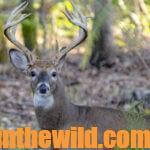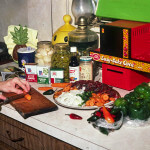Editor’s Note: On a fishing trip with Scott Jernigan and Phillip Criss on Lake Guntersville in north Alabama, we caught plenty of fish. Scott has been a crappie/bass fishing guide for 15 years and has fished for crappie on Guntersville for all his life. Phillip Criss has been a bass-fishing guide for 43 years, and we’ve fished together for the last 30 years. I learned a new technique from them for fishing for crappie and bass. An interesting part of my education while at Lake Guntersville is that I saw and had an opportunity to fish with a Lowrance ActiveTarget Live Sonar (https://www.lowrance.com/activetarget/). Much of what I learned on this trip can be applied throughout the U.S. to catch crappie and bass. Also many of these same patterns will work on other lakes throughout the country, year-round.
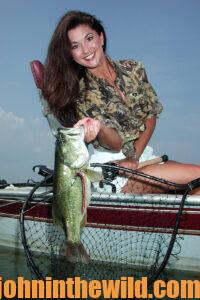 John E. Phillips: Scott, what’s an average day of crappie fishing when you take a party out?
John E. Phillips: Scott, what’s an average day of crappie fishing when you take a party out?
Scott Jernigan: We usually can limit out with 30 fish per person on a 4-6 hour trip. That’s not every day, but most days we do.
Phillips: You also guide for bass fishing. How do you guide to bass on Lake Guntersville?
Jernigan: Some seasonal patterns work at different times of the year. During the late spring and summer months, I’ll fish shallow early in the morning. Then as the sun comes up, I’ll move out to somewhat deeper water. When the sun’s very bright, we’ll move out and fish in deeper water, probably 18-20 feet deep. We start fishing for bass in the winter months, and at that time of the year, we use rattlebaits and chatter baits until the bass move in shallow to spawn. When the bass are spawning, we’ll run a soft-plastic crawfish bait near the bank or cast a Senko type worm that’s about 6-inches long. When I use this worm, I’ll swim it on the surface after rigging it Texas style and using a 1/8- or a 1/16-ounce sinker. I’ll reel the worm slowly, and the bass usually will hook themselves. I’ll generally have my boat in about 6 feet of water and be casting to 2-foot-deep water. The bass will attack the worm from the 2-foot water back to the boat.
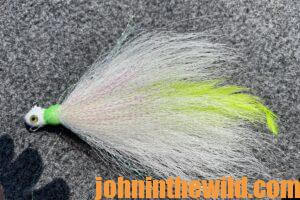
Then when the water reaches 55 to 65 degrees, you can start using a buzzbait, a Pop-R
(https://www.lurenet.com/rebel-pop-r) or a Zara Spook (https://www.lurenet.com/heddon-zara-spook). At the beginning of May, the bass will begin moving out from the spawning areas toward the humps near the river channel. When they reach the deeper water, I’ll use a wobble head with a trick worm on it and drag the wobble head jig and the trick worm over the humps with shell beds on them. At that time of the year, the bass are hungry because the bass are feeding-up after the spawn. Once a bass attacks the trick worm, it usually will hook itself.
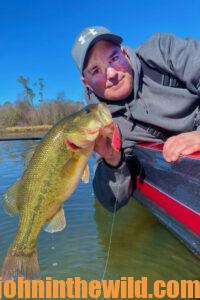 After the bass leave the humps, they’ll move to the river ledges. That’s when I’ll fish a hair jig, a crankbait and/or a Texas-rigged 10-inch worm. The deeper we fish, the bigger the baits we use. When I’m fishing a crankbait, I like the 10XD crankbait made by Strike King (https://www.strikeking.com/en/shop/hard-baits/hc10xd) in a chartreuse color with a blue back that runs 9-10 feet. Sexy Shad is another productive color to use. Another of my favorite baits is a 1-1/2 ounce hair jig. Most of the hair jigs you buy are all white with sometimes a green feather in the middle of the hair. That’s why I like to make my own hair jigs. I’ve found that when bass attack hair jigs, they hit them viciously, plus, hair jigs are easy for people to use. To score a bass with a hair jig, cast the line out, watch the line, and set the hook, if the line twitches. If you don’t catch a bass when the jig falls, allow the jig to hit the bottom, jerk it up, and let it fall back to the bottom. Ninety percent of the time, the bass will take the jig as it’s falling – so watch your line. The hair jig seems to produce the biggest bass from the middle of May to the middle of July. Or, if you see bass schooling – generally in the middle of the summer and the fall – the hair jig can be deadly for catching bass then, especially when you’re fishing ledges with 10 feet above them, and the ledge then drops off into 20 feet of water. Once you find a school of bass that are hungry, you can catch any bass on the hair jig. Although I like the hair jig, when the bass are really feeding, I tell people they probably can catch bass with their tennis shoes (any lure will do).
After the bass leave the humps, they’ll move to the river ledges. That’s when I’ll fish a hair jig, a crankbait and/or a Texas-rigged 10-inch worm. The deeper we fish, the bigger the baits we use. When I’m fishing a crankbait, I like the 10XD crankbait made by Strike King (https://www.strikeking.com/en/shop/hard-baits/hc10xd) in a chartreuse color with a blue back that runs 9-10 feet. Sexy Shad is another productive color to use. Another of my favorite baits is a 1-1/2 ounce hair jig. Most of the hair jigs you buy are all white with sometimes a green feather in the middle of the hair. That’s why I like to make my own hair jigs. I’ve found that when bass attack hair jigs, they hit them viciously, plus, hair jigs are easy for people to use. To score a bass with a hair jig, cast the line out, watch the line, and set the hook, if the line twitches. If you don’t catch a bass when the jig falls, allow the jig to hit the bottom, jerk it up, and let it fall back to the bottom. Ninety percent of the time, the bass will take the jig as it’s falling – so watch your line. The hair jig seems to produce the biggest bass from the middle of May to the middle of July. Or, if you see bass schooling – generally in the middle of the summer and the fall – the hair jig can be deadly for catching bass then, especially when you’re fishing ledges with 10 feet above them, and the ledge then drops off into 20 feet of water. Once you find a school of bass that are hungry, you can catch any bass on the hair jig. Although I like the hair jig, when the bass are really feeding, I tell people they probably can catch bass with their tennis shoes (any lure will do).
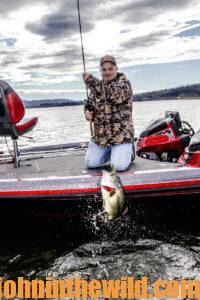 From May to July, often we’ll catch 20-30 bass in a 6-hour trip, if the bass are biting, and we find the right school. What we try to do is put our baits in as many schools as we locate and hope they’re feeding. The average Guntersville bass weighs 4-1/2 pounds, but if you find the right school, you can get into the 5 to 6-1/2 pounders, and occasionally to an 8-10 pound bass. I have caught an 11-pound bass, but she was going on the bed, so I released her. I had a client catch a bass that weighed 9 pounds. During the summer months, generally six or eight of my clients will catch bass weighing over 8-pounds each.
From May to July, often we’ll catch 20-30 bass in a 6-hour trip, if the bass are biting, and we find the right school. What we try to do is put our baits in as many schools as we locate and hope they’re feeding. The average Guntersville bass weighs 4-1/2 pounds, but if you find the right school, you can get into the 5 to 6-1/2 pounders, and occasionally to an 8-10 pound bass. I have caught an 11-pound bass, but she was going on the bed, so I released her. I had a client catch a bass that weighed 9 pounds. During the summer months, generally six or eight of my clients will catch bass weighing over 8-pounds each.
You can reach Phillip Criss at [email protected]; 205-461-5549. To contact Jernigan, you can call Waterfront Bay Grocery and Tackle (http://waterfrontbaygrocery.com/, 256-582-6060); or at: 706-575-7239. You also can email him at [email protected] or go to his Facebook page: Scott Jernigan (https://www.facebook.com/scott.jernigan.31).
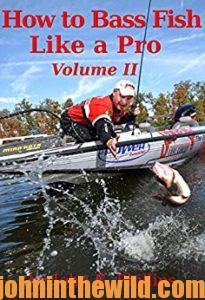 To learn more about bass fishing, check out John E. Phillips’ latest bass book, “How to Bass Fish Like a Pro, Volume II,” at https://www.amazon.com/gp/product/B08Z9W6VC1/ref=dbs_a_def_rwt_hsch_vapi_taud_p1_i9 for Kindle, print and Audible versions. (On right side of the page and below the offer for free Audible trial, you can click on Buy the Audible with one click). You may have to copy and paste this click into your browser. (When you click on this book, notice on the left where Amazon says you can read and hear 10% of the book for free). On the right side of the page and below the offer for a free Audible trial, you can click on Buy the Audible book.
To learn more about bass fishing, check out John E. Phillips’ latest bass book, “How to Bass Fish Like a Pro, Volume II,” at https://www.amazon.com/gp/product/B08Z9W6VC1/ref=dbs_a_def_rwt_hsch_vapi_taud_p1_i9 for Kindle, print and Audible versions. (On right side of the page and below the offer for free Audible trial, you can click on Buy the Audible with one click). You may have to copy and paste this click into your browser. (When you click on this book, notice on the left where Amazon says you can read and hear 10% of the book for free). On the right side of the page and below the offer for a free Audible trial, you can click on Buy the Audible book.
Tomorrow: Catching Zone Bass with Phillip Criss

